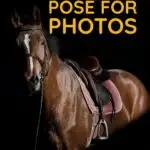One of the fun parts of owning a horse- especially in the 2020’s- is getting to pose with and do social media photoshoots with your horse. As horse owners we are proud of our horses and ponies and want to share our horse-buddies with our friend circle, even those who don’t hang out at the barn with us.
How I Learned to Up My Equine Photography Game by Teaching my Horse to Pose for Photos
When I got my first horse, I was obsessed with taking photographs of him in all his deliciously dapple-gray-with-black-points gorgeousness. As someone who had worked with and shown dogs in the past, I was far more familiar with clicker training (a method popular for training most animals but has been slow to be adopted by horse trainers) than traditional horse training. Although I worked intensively with horse trainers for years to learn the basics of horse handling, horseback riding, and simple training, I also began experimenting with training my horse to do simple tricks using clicker training.
Although at first, I stuck to more traditional “tricks,” like teaching my horse to fetch a jolly ball, I soon began to teach my horse more useful commands like a verbal cue for “squaring up” during lineups at horse shows and eventually, as I explain in detail below, I began to teach my horse how to “pose” for photographs.
Bad Equine Photography
We’ve all been there: You do a mini social media photoshoot with your horse and take 100 photos (all while trying to keep them from curiously schmoozing the camera) and they all turn out looking like an inbred donkey with a facial tic. Unlike photographing other humans (and even dogs- which seem often know to turn on “looking cute” when the camera comes out) horses are the worst at helping you get a good shot. They want to know what you’re doing, they want to be close to you, they want a treat, etc, etc, etc. all of these add up to horses typically moving a lot, shifting their body in weird angles as they explore, and holding their head and ears in strange positions as they ruin your photography attempts in their attempt to understand what’s going on. Here’s the solution to all that: clicker training individual body movements on command.
Anyone can Clicker Train a Horse
Clicker training can sound a little bit complicated but it’s not!
The basic premise of clicker training is this: animals benefit from an immediate marking of the desired behavior during training. With traditional horse training, this reward is a release of pressure, a neck pack, or an “atta boy.” Because this type of reward tends to take a few seconds, during which the animal is taking in other sensory input, training is often slow. Clicker training, in contrast, uses a small handheld “clicker,” to provide an instant audio cue to confirm that the animal has performed the desired behavior and a reward is coming. The animals quickly learn to associate a behavior with the click, and the click with a reward. Because the “click” marker is given so quickly, horses learn rapidly to associate repeating the behavior with getting another click with getting another reward.
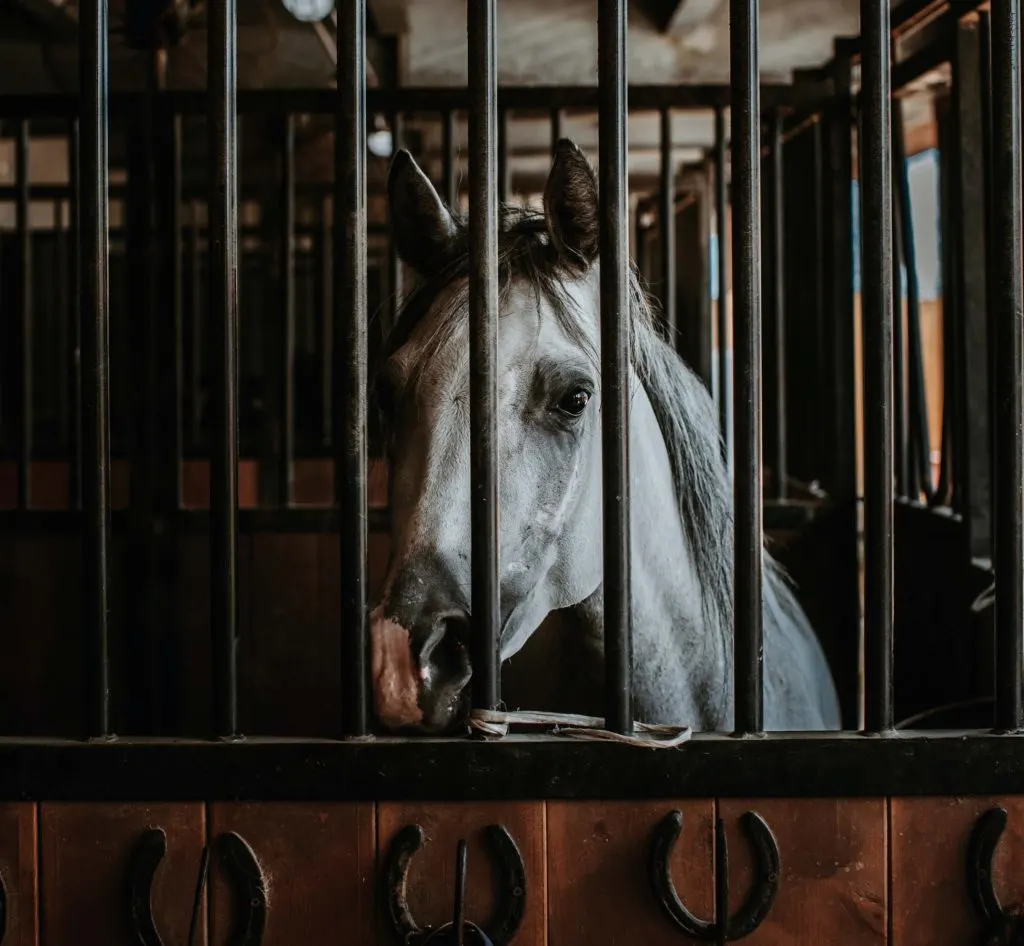
Most horses respond exceptionally well to clicker training and can be taught the cues needed to pose for photos in 1 to 3 short sessions per command. After the initial 1 to 3 training sessions, you’ll need to reinforce the command daily or every other day for about 10-14 days, after which the command should be solid.
What you need to get started
The following section may contain affiliate links. As an Amazon Associate, we earn from qualifying purchases.
All you need is:
- a clicker
- patience
- rewards (see below)
Horse Training Treat Rewards
Generally, clicker training is done with food-based rewards, and horses are no exception. Most horses are very food motivated! When I am clicker training a horse, I use very small treats- such as one carrot or one apple chopped into 10-12 small pieces. Because horses don’t do well with extended training sessions, one carrot is just enough to do a training session or reinforce training without overfeeding. Check out my list of recommended horse treats.
After your horse has learned a cue and is responding consistently with the desired behavior in response to your cue, you can switch to intermittently giving treats (interspersed with rewards of just pats and/or verbal praise) and eventually to no food-treats at all.
Commands to teach your horse to pose for Instagram photos on command, and how to train them:
Horses like to lean, rest one foot, or stand unevenly, which can make for awkward angles in photographs. To get photos of your horse looking strong, even, and at their very best, teach your horse to put all 4 feet on the ground, evenly balanced, at the command “square up.”
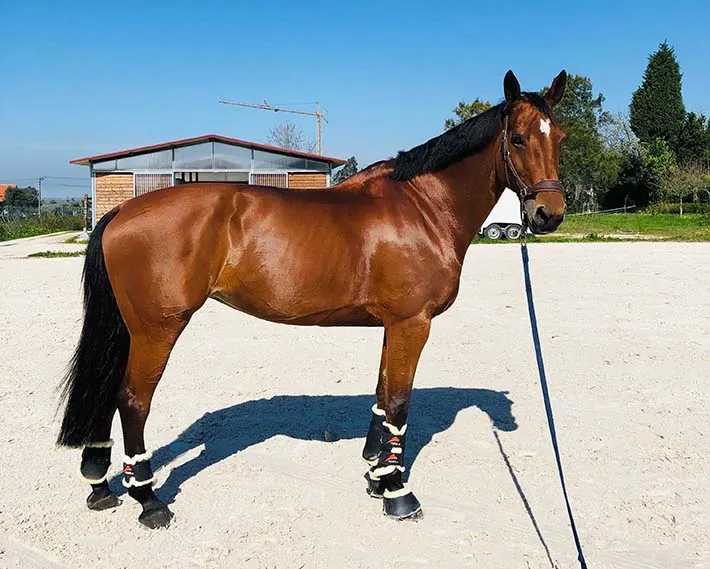
Teach your horse to stand square on command
Gather Training Tools
You’ll need a clicker and a target.
Stand in front of your horse and wait for them to naturally stand even.
With your horse haltered and tethered to a lead rope in your hand, stand in front of your horse and wait. (If your horse just wants to stand with a cocked leg while trying to schmooze for a treat, use the halter to back your horse up, as this often moves the horse naturally into a more square position)
Mark the Desired Behavior
If the horse naturally moves from a casual stance to standing square, click the clicker, say “good square up,” and give the horse a treat.
Repeat
Walk forward a few steps to “reset” the horse’s stance, and begin the process again- which you can then mark with a click and reward.
Continue Training at Intervals
Keep training sessions very brief- no more than 5-10 minutes, but up to 3 times a day. This helps keep horses engaged and learning.
Proceed to Next Trick in our Guide to Training Horses to Pose for Photos
Teach your horse to position head, neck, ears, and tail in just the right way to get the perfect Instagram-worthy photo every time.
Estimated Cost: 2 USD
Supply:
- clicker
- stick or object to use as a target
Teach the Command: “Nose In” to Teach your Horse to Tuck their Nose
Although true collection– which naturally results in a horses nose tucked in slightly towards their chest- comes from momentum and muscle moving a horse’s center of balance into their hindquarters, people often want the look of a tucked-in nose in their photographs – and it’s actually really easy to train a horse to tuck and hold their head in that position on command!
To train the command “nose in”: stand with your horse in a halter or at liberty. Most horses won’t naturally perform this movement so you’ll probably need to add a bit of a stimulus to get the movement the first few times in order to mark it with a clicker. You may need to tickle their chest, press in on their nose, or hold a treat to their chest to get their nose to move inward. Reward even the slightest movement with a click, treat, and “good nose in!” verbal praise.
Over the course of training this trick, gradually begin requiring the horse to hold the position for longer and longer to get the click and treat, and then begin only rewarding the horse when the movement is performed by lifting the whole neck (not just tucking in the nose- full engagement of the neck and shoulders will create a more powerful look in your photos)
Keep in mind that this trick, in particular, requires muscle strength- a bit like flexing your own bicep and holding it- so don’t expect your horse to hold the position longer than their muscle tone can support. With repetition, and especially with regular, correct riding, this position will become easy to hold for photographs.
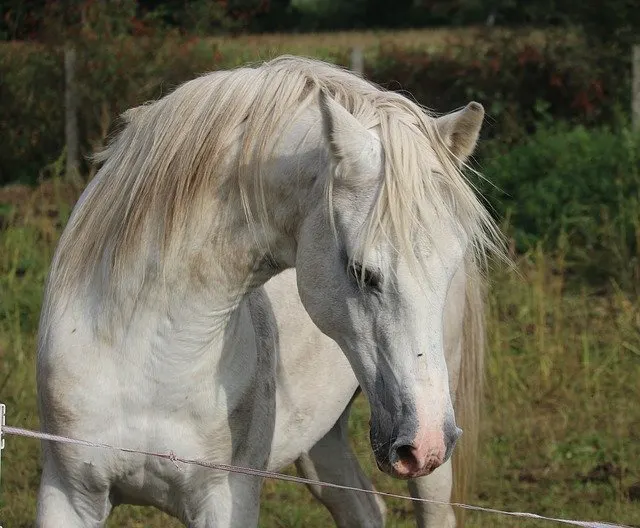
Tip: Use this Trick as Muscle Training:
This “trick” can also be used as a muscle exercise to help recondition and redevelop a poorly muscled ewe neck that has been caused by bracing against a bit or pulling against a martingale or tie-down. Repeating this exercise daily, with an emphasis on being sure the horse lifts their neck and shoulders during the trick, can help build muscle, in the same way that stretching and bodyweight lifting can help humans build muscle.
Teach the Command: “Stand” to Teach your Horse to Stay
We all know what it’s like to have a friendly horse try to crawl into our pocket while we are trying to take a photograph. Teaching the “Stand” (or “Stay”) command is taught in the same way it would be to a dog. Once trained, when told to stand, your horse will stand with their feet glued in position even if you move around, similar to being ground tied.
To train “Stand/Stay”: With your horse haltered and on a lead in a safe enclosed area. Stand in front of your horse, put your hand up in front of you with a “stop” gesture, and take one step backward. Quickly, before the horse has a chance to follow, mark their millisecond-“stay” with a click, and reward. Repeat, this time taking two steps away, click any brief “stay,” and reward. If your horse immediately pursues you for treats, walk forward with your horse for a moment and then begin again. You may have the best luck training this when your horse is already tired from being ridden, and less inclined to follow.
Teach the Command: “Ears Up” to Teach your Horse to Perk their Ears
Nothing ruins a great horse photo like awkward ears sticking out at random angles. Although we don’t think about a lot, horses have an incredible amount of control and awareness of their ears, and they can easily be trained to put their ears in any position you want on command.
To train: “ears up”: with your horse haltered or unhaltered in a safe area such as a pen, closed arena, or even a horse stall or cross ties, stand casually near your horse. Stand long enough, ignoring them, that your horse is relaxed, casual, and not too curious. Then, wait for your horse’s ears to perk up at anything, and the moment they do, click the clicker, say “ears up,” and feed your horse a treat. To repeat, go back to ignoring your horse, wait for the ears to relax, and then click to reward the next time their ears perk up.
After 3 to 5 repetitions, your horse will begin making the connection, at which point you can say to them “ears up.” If their ears perk, click and reward. If they don’t perk up in response to the command, just wait for a natural stimulus to perk their ears and click and reward that. Remember to keep sessions short. This one can be tricky because a horse is naturally inquisitive and will have ears alert to a training process that includes treats!
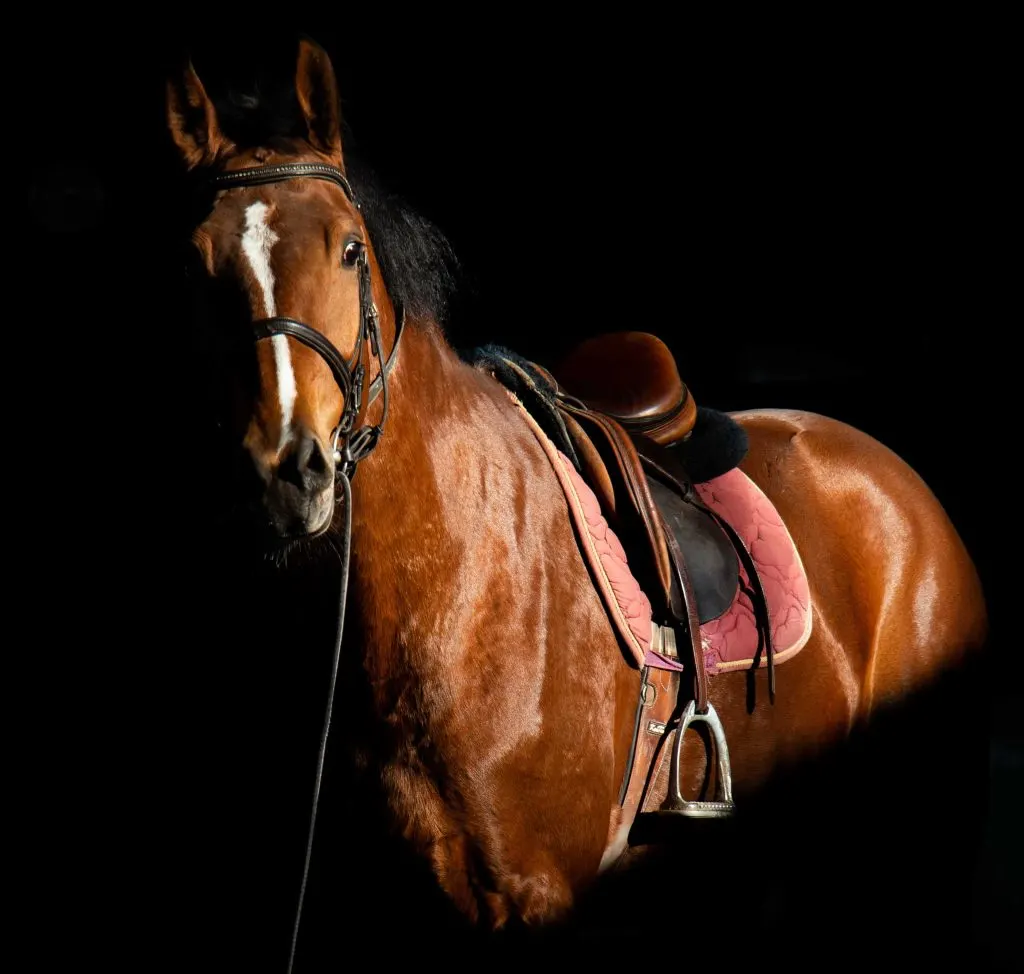
Teach the Command: “Straight” to Teach your Horse to Put their Head Forward
Horses are incredibly responsive to training. At the command of “left”, “right”, or “straight” you can teach your horse to position their neck however you’d like, perfect for posing your horse for equine photography. This command is easier to train with a hand cue paired with the verbal cue so simply match the gesture you choose with the verbal command during your training process.
To train the command “straight”: with your horse loose and at rest in a pen, enclosed arena, or stall, wait for the horse to turn their head to either direction, and when they turn it back click the clicker to mark the movement, say “good straight,” and give the horse a treat. If the horse’s own inquisitiveness keeps its head focused on your direction, you can manually move the horse’s head to one side and when they move it back you can click and reward that movement.

